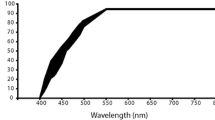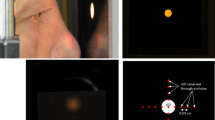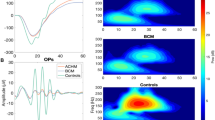Abstract
Effects of chromatic adaptation on C-type bipolar cells (BC) in human retinal fovea are studied. Adaptation of the r-g channel is linear for both central fovea and parafovea. Adaptation of the parafovea bl-y channel, on the other hand, is nonlinear, which is accounted for by the slower adaptation rate of blue-sensitive cones with white light intensity as compared to rates of red- and green-sensitive cones. Achromatic adaptation of red- and green-center BCs produces uniform response decreases but without unique yellow loci shifts. Achromatic adaptation of blue-center BCs, on the other hand, does cause shifts of the unique green locus. Shifts of the crossover points for the BC response spectra occur with chromatic adaptation; the unique yellow loci shifts to shorter wavelengths with adapting wavelengths shorter than 550 nm and longer wavelengths with longer adapting wavelengths than 550 nm. Chromatic adaptation is sufficient to explain the Bezold-Brüke effects; but to fully account for these shifts a novel hypothesis is proposed. For the green and red spectrum regions Bezold-Brücke shifts are due to r-g channel chromatic adaptation, while for the blue spectrum region bl-y channel chromatic adaptation accounts for Bezold-Brücke shifts. The two channels function independently in an either/or manner. The bl-y channel, besides having a unique green locus at 517.7 nm, has a crossover point at about 670 nm. Chromatic adaptation of the bl-y channel produces shifts of the unique red locus, which may account for extraspectral hue shifts.
Similar content being viewed by others
References
Akita M, Cohen, CH (1966) Maintaining an absolute test hue in the presence of different background colors and luminance ratios. Vision Res 6:315–323
Ayama M, Nakatsue T, Kaiser PK (1987) Constant hue loci of unique and binary balanced hues at 10, 100, and 1000 td. J Opt Soc Am A 4:1136–1144
Boynton RM, Gordon J (1965) Bezold-Brücke hue shift measured by color naming techniques. J Opt Soc Am 55:78–86
Cicerone CM, Krantz DH (1975) Opponent-process additivity. III. Effect of moderate chromatic adaptation. Vision Res 15:1125–1135
Cohen JD (1975) Temporal independence of the Bezold-Brücke hue shift. Vision Res 15:341–351
Corene S, Keith K (1970) Bezold-Brücke effect: pigment or neural locus? J Opt Soc Am 60:559–562
Gordon J, Abramov I (1988) Scaling procedures for specifying color appearance. Color Res Appl 13:146–152
Gubisch RW (1967) Optical performance of the human eye. J Opt Soc Am 57:407–415
Guth SL, Massof RW, Bebzschawel T (1980) Vector model for normal and dichromatic color vision. J Opt Soc Am 70:197–212
Hayhoe MM, Benimoff NI, Hood DC (1966) The time-course of multiplicative and subtractive adaptation process. Vision Res 27:1981–1996
Hurvich LM, Jameson D (1955) Some quantitative aspects of an opponent-colors theory. II. Brightness, duration, and hue in normal and dichromatic vision. J Opt Soc Am 45:602–616
Ingling CR Jr, Martinez-Uriegas E (1985) The spatiotemporal properties of the r-g X-cell channel. Vision Res 25:33–38
Ingling CR Jr, Russell PW, Rea MS, Tsou BH-P (1978) Red-green opponent spectral sensitivity: Disparity between cancellation and direct naming methods. Science 201:1221–1223
Jacobs GH, Wascher TC (1967) Bezold Brücke hue shift: further measurements. J Opt Soc Am 57:1155–1156
Jameson D, Hurvich LM (1955) Some quantitative aspects of an opponent-colors theory. I. Chromatic responses and spectral saturation. J Opt Soc Am 45:546–552
Judd DB (1951) Basic correlates of the visual stimulus. In: Stevens SS (ed) Handbook of experimental psychology. Wiley, New York
Larimer J, Krantz DH, Cicerone CM (1975) Opponent process additivity. II. Yellow/blue equilibrium and nonlinear models. Vision Res 15:723–731
Lipetz LE (1988) Universal human visual pigment curves from psychophysical data. Color Res Appl 13:276–288
Nagy AL (1979) Unique hues are not invariant with brief stimulus durations. Vision Res 19:1427–1432
Nagy AL (1980) Short-flash Bezold-Brücke hue shifts. Vision Res 20:361–368
Nagy AL, Zacks JL (1977) The effects of psychophysical procedure and stimulus duration in the measurement of BezoldBrücke hue shifts. Vision Res 17:193–200
Purdy DMcL (1931) Spatial hue as function of intensity. Am J Psychol 43:541–559
Savoie RE (1973) Bezold-Brücke effect and visual nonlinearity. J Opt Soc Am 63:1253–1261
Siminoff R (1991) Simulated bipolar cells in fovea of human retina. Part I. Computer simulation. Biol Cybern 64:497–504
Siminoff R (1991) Simulated bipolar cells in fovea of human retina. Part II. Spectral responses of bipolar cells. Biol Cybern 64:505–510
Smith VC, Pokorny J, Cohen J, Perera T (1968) Luminance thresholds for the Bezold-Brücke hue shift. Percept Psychophys 3:306–310
van der Wildt GJ, Bouman MA (1968) The dependence of Bezold-Brücke hue shift on spatial intensity distribution. Vision Res 8:303–313
Vos JJ (1986) Are unique and invariant hues coupled? Vision Res 26:337–342
Walraven PL (1961) On the Bezold-Brücke phenomenon. J Opt Soc Am 51:1113–1116
Walraven J (1976) Discounting the background — the missing link in the explanation of chromatic induction. Vision Res 16:289–295
Walraven J (1981) Perceived colour under conditions of chromatic adaptation: evidence of gain control by π mechanisms. Vision Res 21:611–620
Werner JS, Wooten BR (1979) Opponent chromatic mechanisms: Relation to photopigments and hue naming. J Opt Soc Am 69:422–434
Author information
Authors and Affiliations
Additional information
The major portion of this work was done while the author was a Senior Research Associate of the National Research Council, USA
Rights and permissions
About this article
Cite this article
Siminoff, R. Simulated bipolar cells in fovea of human retina. Biol. Cybern. 65, 357–364 (1991). https://doi.org/10.1007/BF00216969
Received:
Accepted:
Issue Date:
DOI: https://doi.org/10.1007/BF00216969




